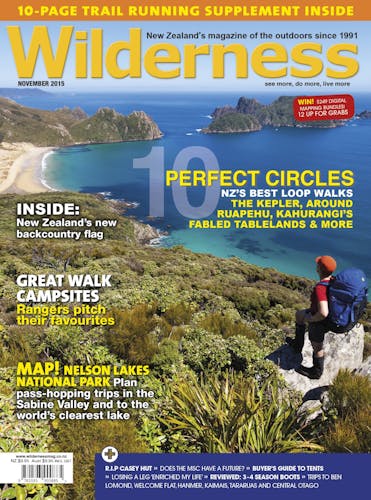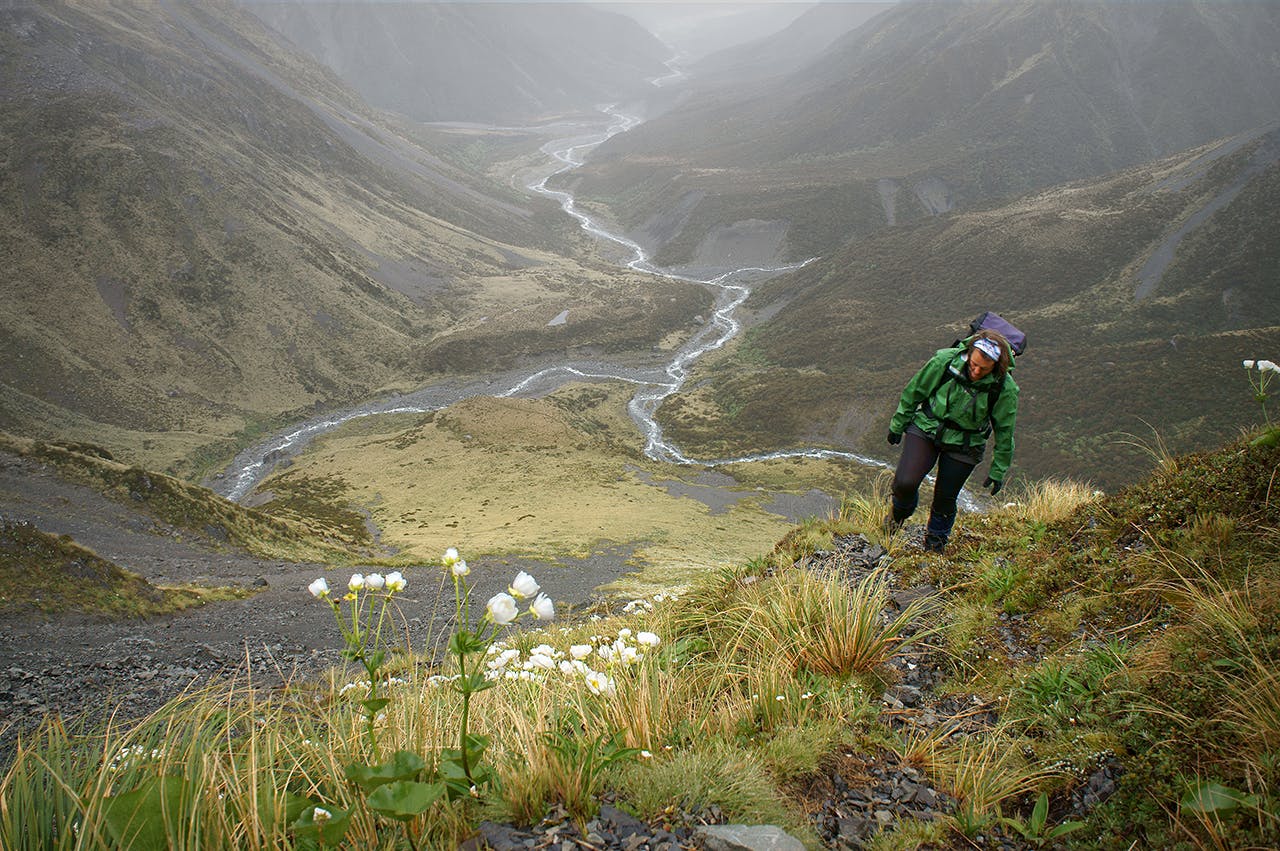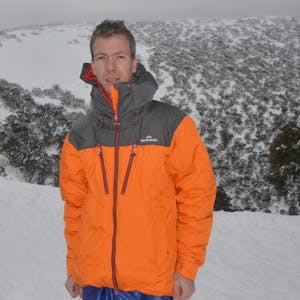Murphy’s Law: after the driest summer on record, Ricky French gets hit by a West Coast deluge and is forced to make a life and death decision.
It had been the driest summer in memory on the West Coast. I was feeling fit, strong, up for a challenge. Many hours were spent researching remote huts, and even more remote mountain passes. I would target largely unknown routes that would test my navigation as well as my fortitude. I unfurled the maps (four in total!) and traced a line past Lake Kaniere to Cedar Flats, then over Mathias Pass into Canyon Creek, over into the Wilberforce River, eventually ending at Klondyke Corner near Arthur’s Pass. The line resembled woozy waves on a graph, seemed to cover an extraordinary amount of kilometres. But I was confident, I was ready.
Then I saw the forecast: heavy rain. I may have been flexible with the route but I wasn’t flexible with the dates. There was no luxury of waiting for the perfect set of days.
“You should have been here last week,” said a Hokitika local as we gathered on the beach to witness the dramatic theatre of an evening bonfire. ‘Or the week before that,’ piped up another voice. ‘We’ve had nothing but sun.’
All around us thick cloud gathered, mimicking the dark tones of the beach: grey, black, the deepest bruise-coloured blue. The punch came, thunder cracked, the bruise opened up and the sky let go. Rain doused the flames and the Coasters pulled down their hoods and scuttled off home. Perhaps they should have had the bonfire last week….
I spent two days mooching round Hokitika, trying to will the forecast into a miraculous change, but it only got worse. My epic route needed revising; you’d have to be a suicidal masochist to want to spend six days bashing your way through rain and flooded rivers and over wind-swept mountain passes.
The maps came out, I would have to go simple. Basic. Naively, I even used the word ‘easy’. The Three Passes it would be. A well-tramped and historic route over Browning, Whitehorn and Harman passes, ending at the same place as my original plan, Klondyke Corner, but in half the time, and with considerably less hardship.
I made a slight variation to the start of the tramp, taking the Arahura Valley instead of the Styx. I talked a local into driving me to the road end where he left me to heave a heavy pack onto my protesting back and walk, ever so slowly, into the hills. The pack weight was going to have serious repercussions; it was digging into my bony shoulders and putting my skinny legs under serious strain before I’d even entered the bush. To occupy my mind I made a mental inventory of my pack, to work out why it was so heavy. Four days’ food, including a few apples – they would have to go; a paperback novel – it would have to earn its keep; a bulky camera, as well as a tripod and a landscape lens as heavy as Westport coal. But the most conspicuous, lumbering offender was the tent, strapped tight to my pack like a barnacle.
The Arahura River looked a picture. It bounced over marbled rocks, washed the riverbank clean, pricked its ears for the coast. As an unexpected bonus, the sun was out. I worked up a drenching sweat, and regretted my first mistake: wearing a cotton T-shirt.
Lower Arahura Hut made a welcome lunch stop, and when I unclipped my pack it fell to the floor with such force I thought it may have damaged the decking. The hut was occupied by two young Maori who were gathering rocks from the river and streams to carry out to sell. Our contrasting reasons for being in the bush led to a strange interaction, where both parties thought the other was crazy. I couldn’t fathom walking hours into the bush to fill my pack with rocks, and they couldn’t understand why someone would walk over the mountains for no financial gain when you could drive. The hut was a modern beauty though, and I hung my sodden T-shirt on the line and wolfed down cheese sandwiches before setting off, leaving the local iwi to their bunks, smoking rollies and listening to tinny techno music through a transistor radio.
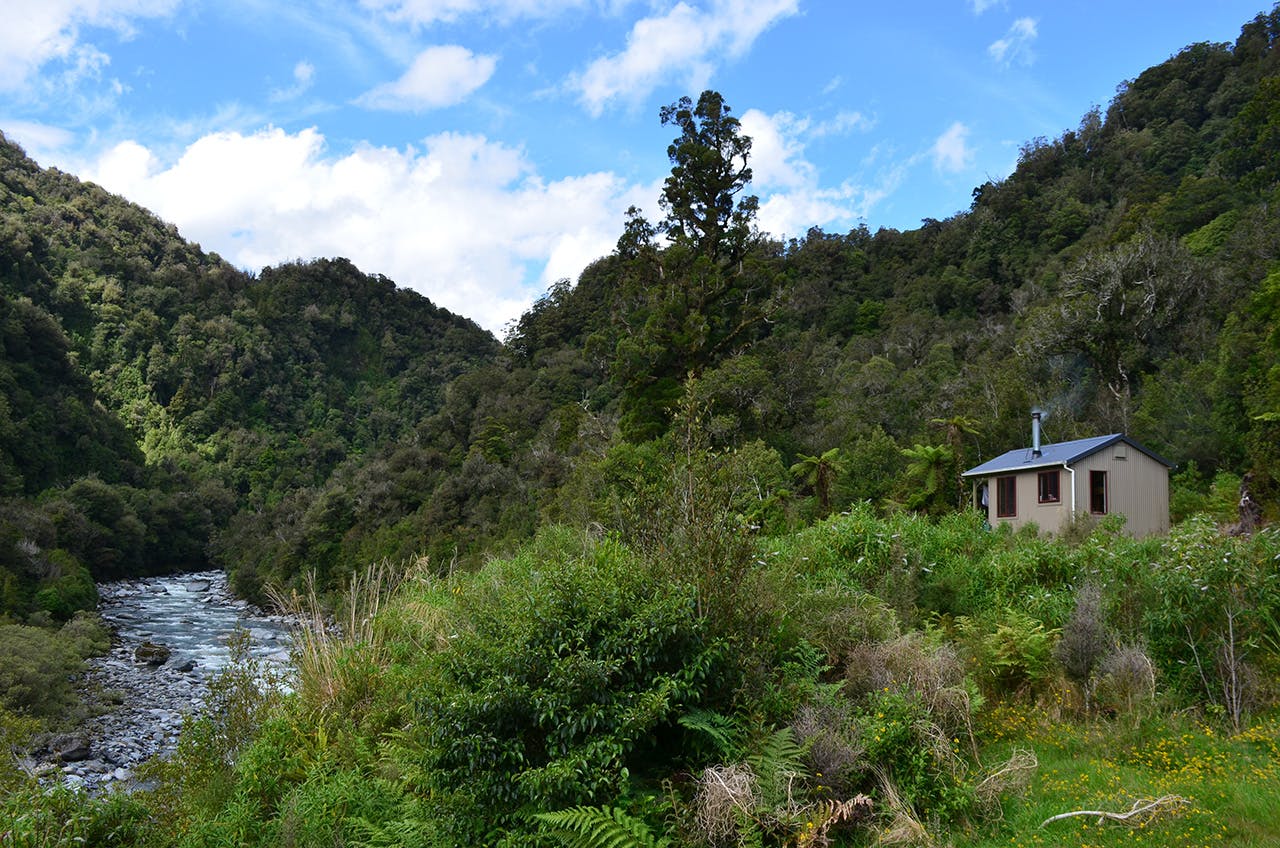
Lower Arahura Hut. Photo: Ricky French
West Coast tramping tracks always keep you occupied. It’s seldom easy going, never boring. Sometimes the track would lead up wide creeks, and have you clambering over boulders as big as cars. Other times a surging waterfall would cut the track in half, requiring careful footwork, holding rocks for support as the tumbling water sprayed off arms and face. In those moments of damp chaos I momentarily forgot the weight of my pack. I was starkly reminded though during my last steps of the day – a brief but steep scramble onto a small bench where Mudflats Hut sits, overlooking the Arahura. My quad muscles suddenly cramped as I made lunging strides up the embankment. The pain was intense, something I’ve never felt before. It went away when I stopped but came searing back if I tried another step. Ridiculously, I was within 20m of the hut. I was thankful no one was there to witness my comical helplessness.
I was in a more positive frame of mind the next morning. Surely my body had adjusted to the exertion being demanded. The first day blues were over and I had an exciting day ahead: to Harman Hut for an early lunch then up and over Browning Pass to Park Morpeth Hut. As I was crossing the swingbridge, two whio slipped below me, riding the white water, sleek, light as air, smooth and polished like greenstone. What luck that our paths crossed at that precise moment. It was divine, but I felt a pang of jealousy seeing the ducks, completely in their element, float effortlessly downstream, while I trod unsteadily on the wobbly wire bridge. Then, gradually worn down by aches and pains, I faced a tough trudge up a mountain valley. The previous day I had felt annoyed at seeing stoat traps lining the track. I thought they spoilt the walk, an aesthetically recurring downer. But now having seen two blue ducks, I immediately saw the traps as a thing of beauty, of hope and good, and I praised each one that I passed.
Harman Hut entered my world after a slow slog. Set above the striking gorges of the upper Arahura, I had entered a sub-alpine area with tussock grass, rocks and mud. The drizzle had increased to a steady rain. My shoulders appreciated the extra padding of the raincoat but a twinge of apprehension spread across my chest as the rain intensified. To reach Park Morpeth Hut I would have to cross the Wilberforce River and I was eager to do this before it rose to dangerous levels. I wasted no time in gulping down a hot drink and some lunch before heading on.
The track to Browning Pass begins in slushy bog, picking its way through shrubs and small trees before reaching the more mountainous and steep upper section of the Arahura. It’s an enjoyable climb, crossing benign side-streams and boulder-hopping up the valley, guided by sporadic cairns. At the business end of the route the landscape steepens and the Arahura is hoisted off the ground, stretched into a torrent of craggy waterfalls. Up higher, the hills were leaking. Skinny sprouts of rainwater were shooting out everywhere, as though the mountainside had been repeatedly stabbed. Wherever I turned my head it was wet.
The full force of the barrage hit me as I levelled out onto the flat plateau that leads past Lake Browning. The change in terrain was stark and isolating. It can be dangerous and narrow but it holds you tight; there are places to shelter. On the tops though, you are small, there’s nowhere to hide, you’re a sitting duck for the elements. And the elements were building to something big. You could see it in the sky; it was working itself into hysterics. The wind was like the swirling cacophony of a gale inside a football stadium. It raced down the mountains from all directions, raked Lake Browning raw, played merry hell with the low cloud, and always sought out its lonely target: me. The mist moved as fast as the wind, materialising and vaporising as it liked, sometimes closing around me in a tight headlock, other times clearing to offer views of what would have been a lovely lake on a sunny day. I could hear the Hokitika locals: ‘You should have been here last week.’
And still the rain let loose. I skirted the lake and made the short climb on the southern side to the edge of the pass proper. During the climb it happened again. Cramp! Excruciating, useless, ill-timed quad cramp. I had no choice but to stop every few steps, try to stretch it out, wait for a lull in the pain then push on. When I finally reached Browning Pass, the cramp was banished from my mind, as the most breathtaking and surprising view opened in front of me. There, one kilometre and 500 vertical metres below lay the Wilberforce River, its streams converging as the valley narrowed. I stood on the edge of a cliff. It was as if the whole mountain had been washed away in a giant slip. The scene was otherworldly, like I had opened a door to a new dimension. Colour was banished from the spectrum; everything but for the lime green vegetation, shades of grey smothering the land, and there, in the distance where the Wilberforce merged to a vanishing point, a tunnel of white light where the sun poked its fingers under the clouds, lifting them off the ground and offering the tease of an escape route. But it may as well have been a galaxy away.
Two physical obstacles stood between me and Park Morpeth Hut: a perilous descent and the Wilberforce River.
I threw off my pack, resting for a moment and staring into the remarkable valley, when a flash of lightning lit up the land, like a strobe light suddenly flicked on. I didn’t have time to jump before the sky cracked with the loudest thunder I’ve ever heard. It nearly blew out my eardrums and sent the fear of God through me. The storm was directly overhead!
I put some distance between myself and my pack, which had my camera tripod sticking provocatively skywards. I remembered what to do in a thunder storm: crouch in a ball with your feet together. I did this, and whimpered feebly as another flash and crack went through. How unfair, I thought, to die from lightning strike on Browning Pass. Would it be my fault? I hadn’t done anything foolish, hadn’t tried to cross a swollen river, hadn’t slipped off a ridge. All I did was follow some cairns to the heavens. There was nothing I could do now except put my faith in the odds. Yes, it was possible I could be sizzled to a steaming ball of sodden tramper, but it was unlikely. Instead, I occupied my mind with decisions. There was danger ahead.
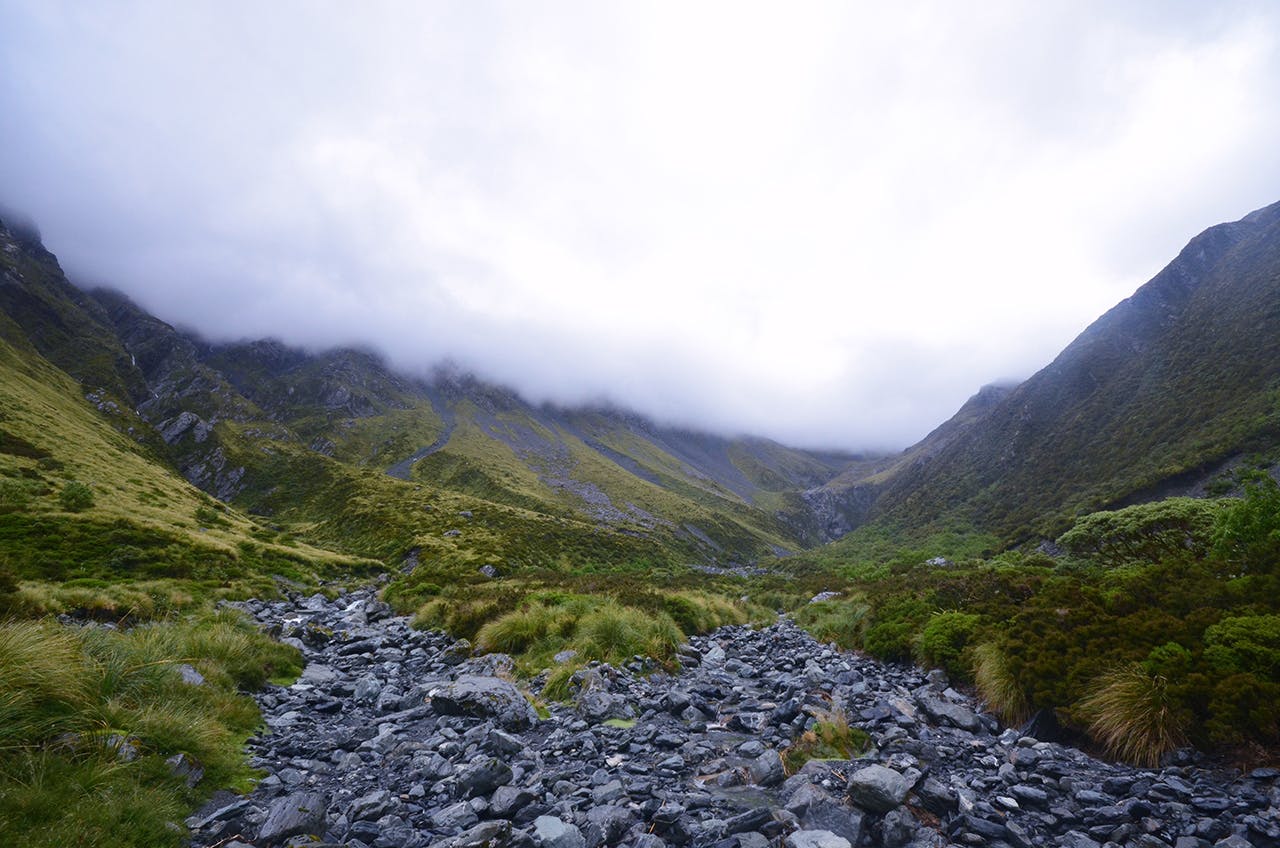
Dark and menacing clouds, heavy with rain, gather at the head of the Arahura Valley. Photo: Ricky French
Descending the slippery rocks of the pass, in storm conditions, with legs that could cramp up at any moment, would be terrifying at best. And what if I made it down? I would still need to cross the Wilberforce River to make it to the hut. From the amount of rain that had fallen in the past few hours, I knew the river would have risen to uncrossable levels. I would have to pitch a tent amongst a clump of small trees at the head of the valley. Yes, doable, but then what? There was every chance the rain wouldn’t let up for days. The river would remain impassable. I would be in no man’s land, in a sodden tent, everything wet, miserable, possibly courting hypothermia, especially if the forecast southerly hit in two days’ time.
I remembered something else: I was standing at the precise point where two historical tramping parties should have turned back. In January 1929, two Coasters drowned after attempting to cross a side stream into the Wilberforce after a storm hit. Park Morpeth Hut was built and named in their honour. In 1956, sixteen year-old Allan Clough drowned while crossing the Wilberforce at the precise place where I would have to. Both parties would have stood where I was, and made a decision to press on. I realised what I had to do, and it was like a weight had lifted from my shoulders. I would retreat to Harman Hut and make my way down the Arahura to Hokitika.
I turned my back on the pass. After making my way down the steeper rocky section, I came to the point where I had to cross the river. Two hours ago it was barely above my boots. Now I couldn’t see a safe crossing point. It was all fast white-water, deep pools, submerged rocks.
I picked my spot and decided to make a quick dash. The longer I left it the more the river would rise. I took two quick steps and sank into waist-deep water. I allowed the current and my momentum to push me to a large rock which I threw my body against, plastering myself flat with arms and legs outstretched, the way you might if you found yourself inexplicably affixed to the side of a rapidly-rising hot air balloon. I called on every muscle fibre in my legs to push up and over the rock, out of the chilling water. The cramping pain hit again, worse than ever, but for once I ignored it. To hell with the pain, I was at last over the rock and out of the river. Surely now it was plain going. Not quite. I still had to cross a multitude of boisterous side streams, many of them impromptu, the overflowing result of spontaneous waterfalls high up on the mist-enclosed mountain. Had I really called the streams ‘benign’ just a couple of hours ago?
At last I gained the track that led through the swamp to the hut. The relief was immeasurable. I threw open the door and laughed at how wet I was. Also, how safe I was. What a situation I had walked into, and out of. The hut fire was a success, the drying commenced. I lay in my sleeping bag and made a list of my mistakes: ignoring the forecast, lack of fitness coupled with an over-abundance of confidence, a stupidly heavy pack.
No further river crossings were needed to get out. With tail between legs and hood over head, I was almost happy. The rain didn’t stop until the following afternoon, when I plodded gingerly back over the swingbridge to Mudflats Hut. But the damage was done. Rain had stopped play. Even the blue ducks had gone home.





